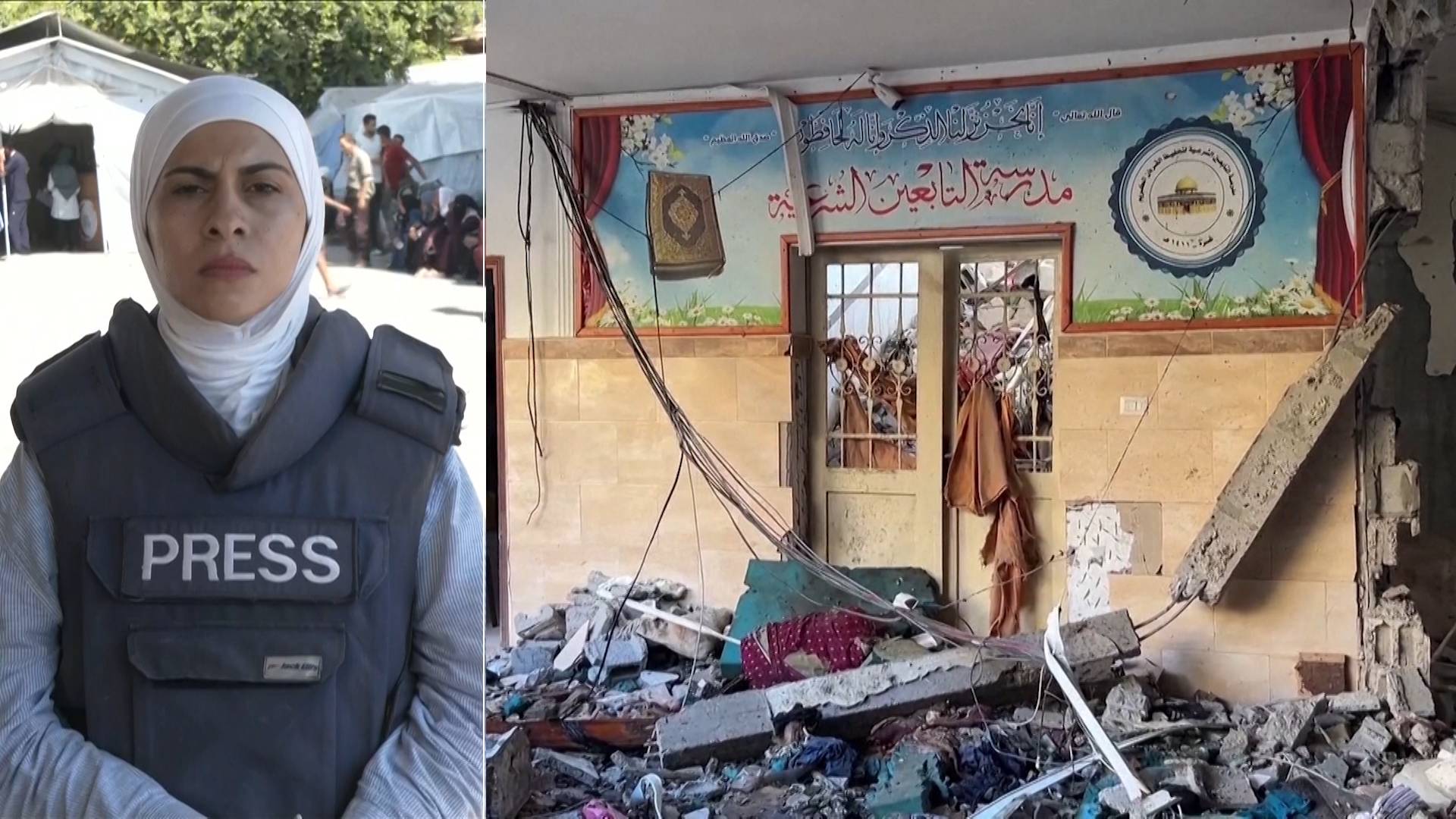This is a rush transcript. Copy may not be in its final form.
AMY GOODMAN: Israeli attacks in Gaza have killed 142 Palestinians in the last 48 hours, according to the Gaza Health Ministry. The official death toll now stands at just under 40,000 with over 92,000 people injured. However, the true number of dead is likely far higher, with many thousands of dead unaccounted for. Figures from the Palestinian Central Bureau of Statistics show Israeli forces have killed 1.8% of the Gaza Strip’s population since October, with 75% of the victims under the age of 30.
Among the deadliest single attacks in Gaza came early on Saturday morning, when Israel bombed the al-Tabin school in Gaza City, where thousands of Palestinians sought shelter. Officials in Gaza say over a hundred Palestinians were killed in the attack, many of them while they were praying at a mosque inside the school. Most of the dead were dismembered or disfigured beyond recognition. According to Mondoweiss, doctors have collected body parts and are handing over plastic bags filled with 70 kilos of human remains to family members of those killed whose bodies cannot be identified.
Meanwhile, CNN has confirmed a U.S.-made GBU-39 small diameter bomb was used in the strike. It was the latest attack on what the United Nations Human Right Office called the, quote, “systematic attacks on schools,” unquote, with at least 21 Israeli strikes on schools, each serving as a shelter, since July 4th alone. The deadly bombing of the al-Tabin school also came two days after the Biden administration notified Congress it’s preparing to provide Israel with an additional $3.5 billion to spend on U.S. weapons and military equipment.
Meanwhile, tens of thousands of Palestinians have been forced to flee the southern city of Khan Younis and sleep on sidewalks and streets after the Israeli military ordered more evacuation orders in the city early Sunday, including in part of a previously designated so-called humanitarian zone. The latest order follows similar directives issued by the Israeli military in the eastern regions of Deir al-Balah, in central Gaza and other parts of Khan Younis Thursday. The vast majority of Gaza’s population of 2.3 million people have been displaced, often multiple times. Khan Younis had already suffered widespread destruction during an Israeli air and ground offensive earlier this year.
For more, we go to Gaza, where we’re joined by Palestinian journalist Shrouq Aila. She runs Ain Media in Gaza and joins us today from outside the Al-Aqsa Hospital in Deir al-Balah.
Shrouq, thank you for joining us. Can you talk about the strike on the Israeli school and mosque on Saturday, how significant this was, with the killing of about 100 people?
SHROUQ AILA: Hi, Amy.
I’m devastating to talk about such topic that happened on Saturday, that we woke up in a very heartbreaking news of targeting a school, which is a shelter for almost 600 displaced people from the Gaza City and the northern part of the Gaza City, as well, and those people who sought shelter at this school, believing that the schools are safe areas, which is absolutely not. And this attack, the Israeli warplane attacked the school with three rockets, left behind over 100 pieces of people. I’m saying “pieces” because nobody were able to recognize the full body of their beloved ones. Like, they’re scattered in pieces. And also, it’s not also about the 100 who got killed in cold blood. As well, there are also thousands who left severely injured. Like, among those injuries, there are lots of amputations, as well. Let me say, the attack happened during the al-Haja prayer, which is a done prayer, like, that is almost at 5 a.m. And after this prayer, most of the people, the displaced people, decided to stay at the mosque to recite Qur’an, and the massacre happened.
AMY GOODMAN: Now, can you respond to what Israel is saying, that it was some kind of Hamas headquarters, yet Euro-Med Human Rights Monitor said Sunday a list provided by the Israeli army of alleged targets at the school include individuals who were killed in previous attacks and civilians who opposed Hamas?
SHROUQ AILA: Look, Amy, like, each severe attack, we used to hear that same narrative from the Israeli side, that this massive attack that left lots of injuries and casualties, that there is always something that is saying that Hamas is behind all of this. But, basically, when it comes to the footage, and when you look deeper at the losses and the names, you see just innocent people, mostly kids and women, as well. So, let me say, it’s just normal. We are getting used to such speech from the Israeli side, that whatever attacks happen, there is that excuse that there is Hamas beyond this. But you know that Gaza is full of — like, is all very crowded with people. Like, it’s almost, like, 200-and-a-half population, and for sure there’s — those people, they are innocent. They are holding hopes, like, to live in peace, and nobody wished for a war, you know?
And if you are switching for the southern part of the Gaza Strip in the past two weeks, the Israeli army issued multiple evacuation orders for the Rafah area, Khan Younis area, Deir al-Balah area, and also Nuseirat. And also, the — even though the north, like lots of evacuation orders, like, every day that happens. Like, you imagine, like, you are suffering to find a spot to set up your makeshift tent and find the access for water, for bathrooms and for essentials, and then eventually it ends up with immediate orders of evacuation. And the only thing that you can do at such a moment is just to flee and run for your safety along with your family members, leaving behind the essentials that painstakingly you gathered with time and money. — There are people I know that have been displaced 15 times.
AMY GOODMAN: Shrouq Aila, if —
SHROUQ AILA: Like, there are people that I know that have been displaced so far plus-15 times. Yeah.
AMY GOODMAN: Can you respond to the latest news of the possibility of ceasefire talks being renewed? Hamas said they want to abide by the Biden proposal, ceasefire proposal, in May. Are talks — what is your understanding of are talks going to resume, and the response of people on the ground in Gaza, where you are?
SHROUQ AILA: Let me say, each time we hear the talk, the peace, the ceasefire talks, each time we hold that hope that it will work out eventually, like, even though it’s never happening on the ground. But, you know, we are — people here are tiring and tired to that level that they stick with every tiny sense of hope that it will end very soon. And after appointing the replacement for Hamas leader, Sinwar, despite the people are with or against this option, still they are hoping that this change will bring and pay back the results of having a ceasefire on the ground.
AMY GOODMAN: I also want to ask you about the killing of Palestinian journalists. It pains me to do this as you stand there with your press flak vest with the clear words “press” on it. Israel bombed the home of the Palestine TV journalist Tamim Muammar in Khan Younis on Friday, killing him along with his wife and two of their children. A separate airstrike on the home of Al-Aqsa TV journalist Abdullah al-Sousi killed him and two of his nephews. This follows the killing of Al Jazeera Arabic journalist Ismail al-Ghoul and his cameraman Rami al-Rifi on July 31st. Your husband, the journalist Roshdi Sarraj, was killed in an Israeli airstrike in October. You’ve taken over the leadership of Ain Media from him. Talk about the latest killing of journalists in Gaza, the number now at this point well over 100 journalists killed.
SHROUQ AILA: According to the Ministry of Health, like almost 100 — plus-160 journalists got killed. Most of them, they were directly attacked by the Israeli army. And frankly, Amy, I’m saying this in very obvious words, that I prefer — whenever I go for filming and coverage, I prefer not to wear the press vest, because I started to believe that this press vest is a threat and we are targeted because of it. It’s never protecting us. It’s not only me. It’s the same feelings that we, all journalists, are sharing with it, that we’re tired of being followed and being threatened and being attacked.
And what we are doing is just screening all the massacres on the screen, like in front of the media. And somehow I feel we are in need for the access of foreigner journalists to come in and join us during this coverage. Maybe they have some words, at live, that we did not say so far, and it’s good to hear the — to hear the reality from other mouths, you know? Because, like, everything has been featured on the screen. We have been slaughtered on the screen, like, since almost plus-10 months so far, and nothing is happening on the ground. It’s just all about following and attacking more and more journalists. And I can say that it puts more pressure on us, especially when it comes to family and your friends and even the people outside in the streets. They are somehow feeling that we are a threat, and are afraid of walking by, like, because we are holding a camera or wearing a press vest. And it’s never a secure feeling that we should feel, especially at just timing of genocide. I think there is a need to make more pressure in the media to have access for foreigner journalists to come in and do more coverage and help us in shooting the war.
AMY GOODMAN: Shrouq Aila, I want to thank you for being with us, independent journalist and producer in Gaza. Again, her husband, Roshdi Sarraj, was killed in an Israeli airstrike in October. She now runs his media outlet Ain Media.
Coming up, “Inside Project 2025’s Secret Training Videos.” Stay with us.
[break]
AMY GOODMAN: Bach’s Prelude to Suite 5, performed by Yo-Yo Ma. In New York City, professional cellist John Mark Rozendaal is facing up to seven years for playing a piece from Bach’s “Suite for Cello” outside the headquarters of Citibank during a climate protest.











Post comments (0)